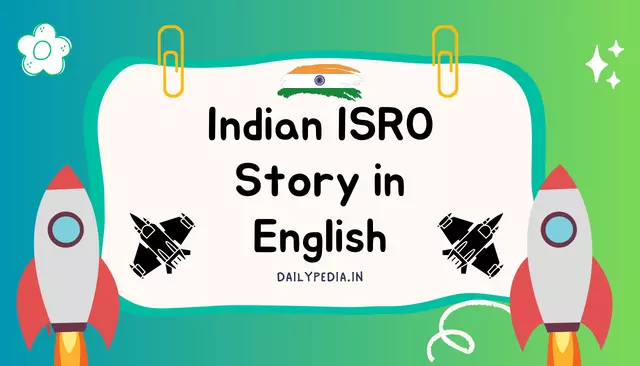The Indian Space Research Organisation, or ISRO, is the space agency of the Government of India. Established in 1969, ISRO has made significant strides in the field of space exploration and technology, earning a reputation for its cost-effective and innovative approach to space missions. Here is the story of ISRO‘s remarkable journey in English:
Indian ISRO Story in English

Early Years and Formation:
ISRO’s roots can be traced back to the establishment of the Indian National Committee for Space Research (INCOSPAR) in 1962. Dr. Vikram Sarabhai, widely regarded as the father of India’s space program, played a pivotal role in its formation. INCOSPAR laid the foundation for the eventual creation of ISRO in 1969.
Aryabhata and the Launch Vehicle Program:
ISRO’s early years were marked by the launch of its first satellite, Aryabhata, in 1975 from the Soviet Union. This achievement was a significant milestone for India in the field of space technology. Concurrently, ISRO initiated the development of indigenous launch vehicles, with the successful launch of Rohini Satellite Launch Vehicle (SLV) in 1980.
Milestones and Notable Missions:
ISRO continued to achieve milestones in the following decades. In 1983, the organization successfully launched the Rohini Satellite Series. The 1990s saw the launch of the Polar Satellite Launch Vehicle (PSLV), which became ISRO’s workhorse for launching satellites into polar orbits. The PSLV was instrumental in launching India’s remote sensing and communication satellites, facilitating applications in agriculture, weather forecasting, and communication.
Global Recognition:
ISRO gained international recognition in 2008 with the Chandrayaan-1 mission, India’s first lunar exploration endeavor. The mission discovered water molecules on the Moon’s surface, cementing India’s position in lunar exploration. Subsequently, in 2013, ISRO successfully launched the Mars Orbiter Mission, also known as Mangalyaan, making India the fourth space agency in the world to reach Mars and the first to do so on its maiden attempt.
Commercial Launch Services:
ISRO expanded its services by offering commercial satellite launch services through its commercial arm, Antrix Corporation. This venture brought in revenue and established ISRO as a reliable and cost-effective option for satellite launches.
The PSLV-C37 World Record:
In 2017, ISRO set a world record by launching 104 satellites in a single mission using the PSLV-C37. This accomplishment demonstrated ISRO’s prowess in launching multiple satellites simultaneously and further solidified its reputation in the global space industry.
Challenges and Future Endeavors:
ISRO has faced its share of challenges, including setbacks such as the GSLV-D3 mission failure in 2010. However, the organization remains determined to overcome obstacles and continue its pursuit of space exploration. Future plans include the Gaganyaan mission, India’s first manned spaceflight program, and the Aditya-L1 mission, which aims to study the Sun.
Conclusion:
ISRO’s journey from its inception in 1969 to the present day is a testament to India’s commitment to space exploration and technology. With a string of successful missions, international collaborations, and cost-effective approaches, ISRO has carved out a prominent place in the global space community, contributing to scientific research, national development, and humanity’s understanding of the cosmos. Its continued endeavors promise an exciting future for India’s space program.
Share With Your Friends